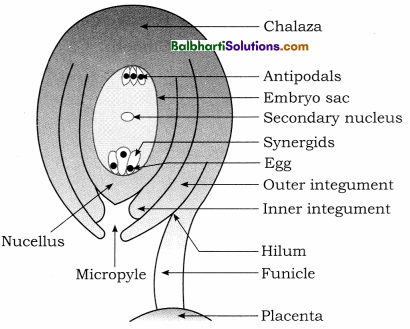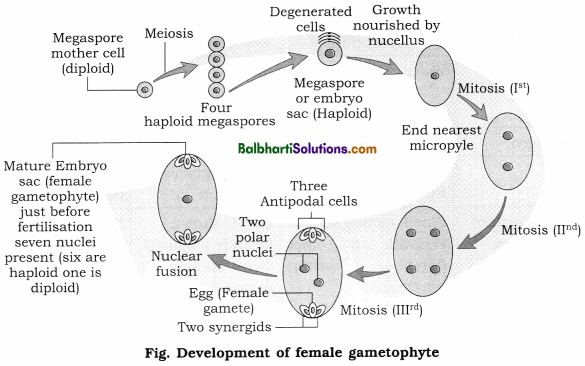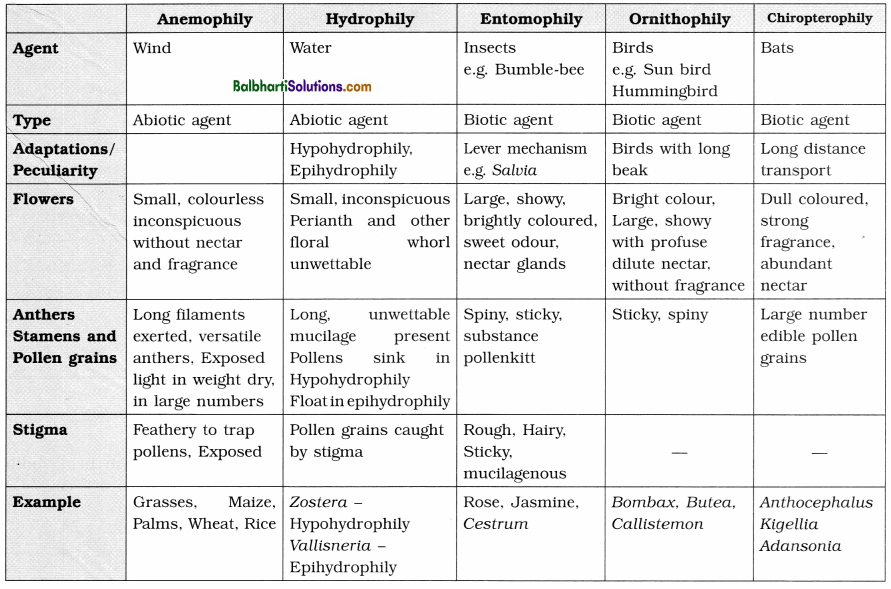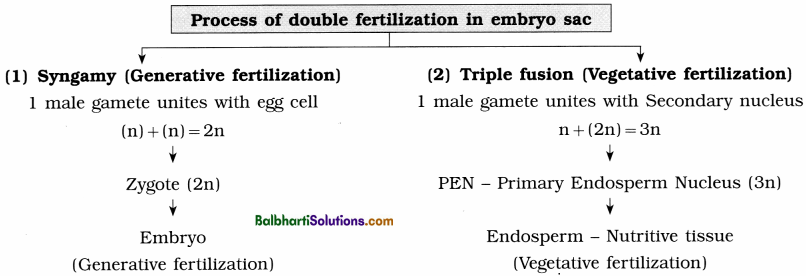By going through these Maharashtra State Board 12th Science Biology Notes Chapter 1 Reproduction in Lower and Higher Plants students can recall all the concepts quickly.
Maharashtra State Board 12th Biology Notes Chapter 1 Reproduction in Lower and Higher Plants
Introduction – Reproduction
- Reproduction is production of young ones like parents.
- Essential Process related to continuity of species.
- To maintain continuity of life, organisms produce offspring showing similar characters.
- TWo types – Asexual reproduction and Sexual reproduction.
Asexual reproduction
1. Fusion of two compatible gametes or sex cell is not involved.
2. Production of genetically identical progeny, i. e. Clones.
3. Progeny from single organism.
4. Inheritance of genes of parent by progeny.
5. Modes of Asexual Reproduction
(1) Fragmentation
- Multicellular organism
- Small piece
- Accidental breaking E.g. Algae Spirogyra.
(2) Budding
- Unicellular organism
- One or more outgrowths, i.e. buds
- E.g. Yeast
(3) Spore formation
- Different types
- Flagellated motile zoospores
- Zoosporangia
- Biftagellate zoospores. E.g. Chlamydomonas
![]()
(4) Fission
Binary Fission E.g. Amoeba, Paramoecium
(5) Conidia formation
E.g. Fungus Penicillium
(6) Gemmule formation
E.g. Sponges
6. Vegetative reproduction :
- Asexual method
- Reproduction with vegetative plant parts.
- Artificial methods useful in agriculture and horticulture.
- New plants are identical to parent plant
7. Artificial methods-
(1) Cutting
Small piece of plant part selected.
Must possess one or more bud.
- Stem cutting
e.g. Rose, Bougainvillea - Leaf cutting
e.g. Sansev feria - Root cutting
e.g. Blackberry
(2) Grafting
- Joining of two plant parts stock and scion
- Rooted plant — Stock
- Joined plant – Scion
- Grow together as one plant
- Stem grafting e.g. Apple
- Bud grafting, budding e.g. Rose
(3) Tissue Culture
- A small amount of plant tissue is carefully and aseptically grown to get plantlets.
- Micropropagation — Modern method to get plants from tissue culture. e.g. Orchids
Sexual Reproduction-
1. Involves fusion of two compatible gametes (male and female).
2. Takes place after certain maturity.
3. In higher plants, flowering indicates beginning of reproductive phase.
4. Production of genetically different offspring.
5. Variations are useful for survival and evolution of species.
6. Flowers, specialized reproductive structure producing haploid gametes-

7. Sexual reproduction – Two major events –

Meiosis-
Production of gametes (n):
- Male gametes in anther
- Female gametes in ovule
Fusion of gametes (Fertilization):
- Diploid zygote
- Embryo
- New plant-(2n) sporophyte
![]()
8. Diploid sporophyte is dominant plant body → Meiosis → Haploid spores →
gametes ← within flower ← Reduced structure ← gametophyte
9. Structure of anther – Mature anther :
- Usually dithecous (Having two lobes) → tetrasporangiate (Having four pollen sacs)
- Monothecous (Having single lobe) → Bisporangiate (Having two pollen sacs)
- When young it is homogeneous.
- Parenchymatous with epidermis.
- Heterogeneity appears with formation of archesporial cell.
10. T. S. of anther :
- Mature anther has anther wall and microsporangium.
- Anther wall is outer layer and microsporangium has sporogenous tissue.
- Anther wall has four layers, viz. Outer epidermis (Protective) followed by fibrous endothecium, thin walled middle layers and tapetum innermost nutritive layer.
- Microsporangium contains microspore mother cells (2n) which undergo meiosis to form microspore tetrad.
- Haploid (n) microspores separate from tetrad.
- When microspores develop wall around it then it is known as pollen grain.
- From archesporial cell primary parietal cell forms anther wall and sporogenous cell forms sporogenous tissue.
Microsporogenesis-
1. Process of formation of Microspores by meiosis from MMC — Microspore Mother Cell
2. Pollen grain – Non-motile with single nucleus.
Haploid
3. Pollen wall, double layered — Sporoderm
4. Pollen wall-
- Exine (outer wall)
- Intine (inner wall)
Exine (outer wall)
- Thick
- Composed of non- biodegradable sporopollenin
- Protective layer
- Smooth or variously sculptured, spiny
- Presence of thin areas germ pores for emergence of pollen tube
Intine (inner wall)
- Thin
- Cellulose and pectin
- Forms pollen tube
- Smooth
5. Pollen Viability : It is the ability of pollen grain to germinate and develop male gametophyte.
- Depends on environment factors – Temperature and humidity.
- It lasts for few minutes (Grasses, Wheat, Rice) to months (Members of Rosaceae, Solanaceae, Fabaceae, Leguminosae)
6. Development of male gametophyte :
- It is considerably reduced.
- Develops in flower.
- Pollen grain (n) is first cell of gametophyte.
7. Pollen grain-
1. First mitotic division → 2 unequal cells →
- Vegetative cell
- Generative cell
Vegetative cell
- Larger, Naked
- Rich in food
- Irregular nucleus
Generative cell
- Smaller, thin walled
- Dense cytoplasm
- Floats in cytoplasm of Vegetative cell
2. Second mitotic division → In generative cell → equal cells
- Two non-motile male gametes produced
- Either occur in pollen grain or in pollen tube.
3. Pollen grains are shed in either two celled stage or three celled stage.
- Pollen grains are lodged on stigma of pistil.
Structure of Anatropous ovule (Most common type)
1. Anatropous Ovule:

Ovule are preset in ovary.
Uniovulate – Mango, Wheat, Rice.
Multiovulate – Tomato, Lady’s finger
3. Parts of ovule :
- Funiculus : Stalk by which ovule is attached to placenta.
- Hilum : Point of attachment.
- Anatropous ovule : Curved ovule, where micropyle is near stalk.
- Nucellus : Parenchymatous tissue that forms body of ovule.
- Integuments : Outer and inner two protective coverings.
- Micropyle : Narrow opening at apex.
- Chalaza : Base of ovule.
- Female gametophyte or embryo sac remains embedded in nucellus.
Oval, elongated, multicellular 7 celled structure.
Megasporogenesis-
1. Process of formation of haploid megaspores from Megaspore Mother Cell (MMC) which is diploid (2n).
2. Megaspore mother cell is situated in nucellus towards micropylar end.
3. By meiosis → Linear tetrad of 4 megaspores (n).
4. Upper 3 degenerate but lower one is functional,
- Functional megaspore – First cell of female gametophyte
- 1st mitosis -2 nuclei which migrate to opposite poles
- 2nd mitosis-2 nuclei formed at each pole
- 3rd mitosis-4 nuclei formed at each pole
- One from each pole moves towards centre – polar nuclei
5. Egg apparatus : 3 nuclei at micropylar end.
6. Central egg cell with 2 synergids.
7. Synergids with filiform apparatus – guides pollen tube towards egg.
8. Antipodal cells : 3 cells at chalazal end.
9. Definitive or secondary nucleus : 2 Polar nuclei fuse in central cell – form diploid nucleus.
10. This 7 celled 8 nucleate mature embryo sac is monosporic and endosporic, enclosed in ovule.

![]()
Pollination-
1. Pollination : Transfer of pollen grains from anther to stigma of flower.
- Pollen grains are non-motile and female gametes are produced at different site. To bring both gametes together, this is a necessary act.
- Agents of pollination also act as agent for seed dispersal.
2. Types of Pollination :
(1) Self pollination – Inbreeding
- Occurs in single flower or two flowers in same plant.
- Autogamy : Bisexual flower pollinated by its own pollen shows autogamy.
- Offspring produced by self-pollination is genetically identical to parents, e.g. Pea.
(2) Cross Pollination – Outbreeding
- Xenogamy : Two different plants are involved.
- Need pollinating agent.
- Genetically varied offspring e.g. food and fibre crops
(3) Types of cross pollination :
- Chasmogamy : When flowers open and expose their sex organs.
- Homogamy : Condition when anther and stigma mature at same time.
- Cleistogamy : Condition when flowers remain closed, e.g. Viola, Commelina.
- Geitonogamy : Conditon where transfer of pollen grains to stigma of other flower produced on same plant, e.g. Unisexual flowers of Cucurbita.
3. Agents of Pollination:

4. Comparison of different mechanisms of pollination:

Outbreeding devices – Contrivances-
1. Mechanism to prevent self-pollination and promote cross pollination.
2. Self-pollination results inbreeding depression, hence cross pollination needed.
3. Devices observed in plants.
(1) Unisexuality:
- Unisexuality flowers
- Dioecism e.g. Maize or Monoecism e.g. Papaya, Mulberry
(2) Dichogamy:
- Maturity at different times for anthers and stigma
- Protandry earlier maturity of androecium e.g. sunflower
- Ptotogyny earlier maturity of gynoecium e.g. Gloriosa
(3) Prepotency:
Rapid pollen germination on other stigma of same type e.g. Apple.
(4) Heteromorphy:
- Different forms of flowers
- Stigmas and anthers placed at different levels.
- Divided into two types
- Heterostyly
- Hcteroanthy e.g. Prtmula
(5) Herkogamy :
- Natural physical barrier between sex organs.
- Contact of pollen with stigma is avoided. eg. Calot ropis
(6) Self – sterility:
- Genetic mechanism
- Inhibits pollen germination on stigma of same flower e.g. Tobacco, Thea

![]()
Pollen-Pistil Interaction-
1. Pistil has ability to recognise right type of pollen.
2. Special proteins help in determining compatibility.
3. Physiological mechanism operates on stigmatic surface.
4. Compatible pollen absorbs water and nutrients.
5. Pollen tube emerges from germ pore and passes through style to ovule.
6. Tip of pollen tube enters synergid.
7. Growth of pollen tube is determined by specific chemicals.
8. Pollen grains can be induced to grow on artificial medium having sucrose and boric acid – in vitro tube growth.
9. Artificial hybridization :
- Crop improvement and plant breeding programmes
- Selected desired pollens are handpicked and pollinated.
- Emasculation (Removal of anthers before opening of flowers) and bagging are important steps.
Double fertilization-
1. Complex fertilization mechanism where both male gametes participate.
2. Characteristic feature of angiosperms
- Porogamy : Pollen tube entering the ovule through micropyle.
(Most common type – enters synergid and releases its content – 2 non-motile male gametes) - Chalazogamy : Entry of pollen tube through chalaza.
- Mesogamy : Entry of pollen tube through integuments.
- Siphonogamy : Non-motile gametes present in pollen tube.
Process of double fertilization :
Process of double fertilization in embryo sac
(1) Syngamy (Generative fertilization)
- 1 male gamete unites with egg cell, (n) + (n) =2n
- Zygote (2n)
- Embryo (Generative fertilization)
(2) Triple fusion (Vegetative fertilization)
- 1 male gamete unites with Secondary nucleus, n+(2n)=3n
- PEN – Primary Endosperm Nucleus (3n)
- Endosperm — Nutritive tissue (Vegetative fertilization)

Both male gametes are utilized in the fertilization process hence it is described as a double fertilization.
4. Significance of double fertilization :
- Unique feature of angiosperms.
- Concerned with production of seed.
- Zygote develops into embryo which in turn forms new plant.
- Triploid PEN forms endosperm – nutritive tissue for developing embryo.
- Restoration of diploid chromosome number.
- Avoids polyembryony.
Development of Endosperm-
1. Post fertilization event.
2. Developed from triploid PEN.
3. Development of embryo and endosperm is simultaneous.
4. Endosperm also regulates growth of embryo.
5. Types of endosperm:
(a) Nuclear
- Free nuclear divisions
- No wall formation
- Large central vacuole
- Wall formation at later stage
- e.g. Coconut, Wheat, Sunflower
(b) Cellular
- Divisions of PEN followed by wall formation
- e.g. Petunia
Adoxa
Balsam
(c) Helobial:
- First division of PEN followed by wall formation
- 2 celled unequal
- Smaller chalazal cell and larger micropylar cell
- Further free nuclear divisions
6. Mosaic Endosperm : It is variation in the endosperm having tissue of two different types, e.g. Corn – Patches of different colours giving mosaic pattern.
Development of Embryo-
1. Embryogenesis : The process of development of zygote into embryo is called Embryogenesis.
2. Zygotic embryo is situated towards micropylar end in embryo sac.
3. When some amount of endosperm is formed then only growth of embryo starts.
4. Zygote develops wall around it and becomes
oospore.
5. Oospore divided into 2 celled pro-embryo.
6. 2 celled proembryo
- Larger Cell
- Smaller Cell
Larger Cell
- Towards micropyle
- Called basal cell.
- Suspensor initial
- Transverse divisions to form filamentous suspensor
- Suspensor pushes embryo
- First swollen cell – Haustorium
- Lowermost cell is hypophysis
- Hypophysis forms radicle, root cap.
2. Smaller Cell:
- Towards Chalaza
- Called terminal or apical cell
- Embryonal initial
- 3 mitotic divisions
- 8 cells – octant
- Lower tier forms hypocotyl and part of radicle
- Upper tier forms plumule and Cotyledon
- Divisions to form heart shaped
- TWo lateral cotyledons
- Curvature – Horse shoe shaped
7. Embryogenesis is similar till octant stage in dicot and monocot embryo development.
8. In Monocot embryo – Single cotyledon
- Scutellum – shield shaped cotyledon
- Coleorhiza – Protective covering of radicle
- Coleoptile – Protective covering of plumule Unit
![]()
Seed and Fruit development-
1. Formation of seeds inside fruit for creating offspring for next generation.
2. Fertilization initiates seed formation.
3. Integuments form seed coat – Testa : Outer integument.
Tegmen : Inner integument.
4. Perisperm : Remnants of nucellus in seed e.g. black pepper, beet
5. Pericarp : Ovary wall becomes fruit wall
6. Seed
- Endospermic or albuminous- e.g. Castor, Maize
- Non-Endospermic or exalbuminous e.g. Bean. Pea
7. Cotyledons : Store food materials.
8. Micropyle in seed coat: For emergence of radicle.
9. Significance of Seed and Fruit Formation
- Nourishment to seed that is present inside fruit.
- Protection of seed.
- Propagating unit.
- Dispersal, spread of species.
10. Seed dormancy – Structural and physiological adaptive mechanism for survival.
11. Helpful during adverse environmental conditions.
Apomixis –
1. Phenomenon of formation of embryo through asexual methods.
2. Apogamy : Gametophytic cell produces embryo without fertilization.
3. Apospory : Sporophytic cell produces embryo without fertilization.
4. Agamospermy : Seed is produced but embryo inside is formed without meiosis and syngamy.
5. Apomixis
(A) Recurrent
- Diplospory – unreduced.
- Diploid embryo sac from megaspore mother cell.
- e.g. Taraxacum
- Apospory – apomictic embryo sac.
(B) Non-recurrent
- Parthenogenesis, Embryo formed from egg cell (n)
- Apogamy – embryo from haploid cell.
- Sterile plants.
- e.g. Nicotiana
(C) Adventive Embryony
- Addition to zygotic embryo, embryo formed from nucellus or integuments.
- e.g. Mango, Lemon, Orange.
Parthenocarpy-
1. Parthenocarpy: Fruit formation without fertilization.
2. Stimulus provided by placental tissue.
3. Chemical stimulus of auxins (IAA) responsible for enlargement of ovary.
4. No seed formation (seedless).
5. E.g. Banana, Pineapple, Papaya
6. Can be induced artificially by spraying hormones gibberellins or other physical methods.
E.g. Grapes.
Polyembryony-
1. Development of more than one embryo in the seed
2. Adventive Polyembryony : Embryo
development from nucellus or integuments.
3. Cleavage Polyembryony : Cleavage of zygote pre-embryo and the units develop into embryos.
4. Advantages :
- Genetically uniform seedlings.
- Emergence of multiple seedlings.
- Beneficial in horticulture – Growing fruits.
![]()
Learn this as well :
- Fibrous endothecium of anther wall helps in the dehiscence of anther when pollen grains are mature.
- Pollination by animals is known as zoophily. Animals like snakes, rodents, squirrel, monkeys, lemurs and elephant act as pollinating agents.
- Pollination by snails and slugs is known as malacophily.
- Pollenkitt substance in insect pollinated pollen grains is contributed by tapetum.
- In ovule, the part of the funiculus united with body of ovule, ovule wall is known as raphe. It is seen as a line or a Ridge.
- In maize grain, aleurone layer is the outer part of starchy endosperm which stores proteins.
Know your Scientist/Conservationist :
- Nawaschin : Discovery of phenomenon of double fertilization in Liliaceae family plants : Lilium and Fritillaria.
- Noll : Coined term parthenocarpy.
- Leeuwenhoek : Noticed polyembryony in Citrus seeds for first time.
- Rahibai Popare : Conservationist of Maharashtra, seed mother, created seed bank for varieties of native seed.